Living on $42.00 per Week-Summary
July 25th, 2007From the moment we first heard about Congressmen giving up cocktail parties so they could stick to the Food Stamp diet, we asked ourselves if we could live on $42.00 worth of food each week. We knew the answer to be yes, but we decided to document the effort. Last week, we shopped and cooked as if we, too, had to get by on food stamps. Here in Florida, that means $21.00 per week for each eligible household member. Our household is comprised of two food writers who love to cook.
We began our week-long experiment on Sunday, July 15, with $42.00 and the smugness of insiders. We ended our week on Saturday night with a steak on the grill and $5.46 remaining. Today, we’re talking about how we did it; whether we could sustain our enthusiasm if the dependency were real; and what we could have done better.
As we studied the Web pages describing how others had attempted to meet “The Food Stamp Challenge,” we noted that many of the participants didn’t cook. They simply went to a grocery store and bought the cheapest food they could find.
Recently the restaurant critic at one of Sarasota’s alternative newspapers did a feature on “The Food Stamp Challenge.” The author contrasted his own food choices with those of two young women with children, who really do receive food stamps. By his own admission, the critic’s synthesized experience was not a happy one. The women, who did not go into great detail about their meals, seemed to have worked our strategies for meeting their personal needs.
We suspect that most of the public figures participating, unlike the food-stamp mothers, didn’t spend the sort of time we did thinking about how one would shop and prepare a week’s meals. Political office-holders have other agendas. Furthermore, we started our project with significant advantages over most who had attempted this challenge before us.
• We’re foodies. We cook—from scratch, and we actually like grocery shopping and creating meals. For people like us, hunting for food bargains can be as much fun as yard sales and Ebay are for others.
• We’re informed—over-informed, some might say—about food issues, nutrition, and myriad ways to prepare food. Our favorite lunchtime conversation is, “What shall we have for dinner?”
• We began the week with a well-stocked larder: among other staples, we already had our bargain-priced 3-litre bottle of extra virgin olive oil (e.g., we did not have to lug it home in a folding shopping cart in 92 F. heat nor did we have to drive to BJ’s to buy it.) Nevertheless, if we dipped into the pantry for something that made a significant contribution to our diet (the milk for our coffee, olive oil, bread we had frozen),we deducted its cost from our budget as if we had actually purchased it with our Food Stamp funds.
• Because we own cars, we’ve no problem getting to the Vietnamese grocer on Fridays when he has fresh, whole kingfish. Or swinging into a Publix parking lot because it’s an easy right-hand turn and we just remembered their 2-for-1 special on canned garbanzo beans.
• We live an easy drive from an open-air produce market where we can buy more than a week’s worth of produce for approximately $11.00.
So how was our week? Were we preoccupied with food? Absolutely, but then, because of our professions, we usually are. However we were not hungry between meals, and very satisfied as we made and consumed them. Certainly, we needed to be attentive to what we planned to eat and to whether or not we’d need to draw down our allotment. We cooked and sat down to eat two nourishing and delicious meals every day. We didn’t feel the need to snack, except for a few handfuls of sunflower seeds.
We suffered no symptoms of fatigue or cabernet sauvignon withdrawal. Of course, wine isn’t eligible for the food stamp budget anyway, but it does soothe hunger. And although we often have wine with dinner, to play fair, we didn’t consume any during the challenge. To sum up, we did well, extremely well, and ate pretty much as we usually do.
A nutritionist we know checked in during the week to tell us that she absolutely loved our food journal and intended to direct her entire mailing list to our blog. If she were more doctrinaire, she could have scolded us for not eating a “balanced” breakfast. But, if our mothers couldn’t do it when we were teenagers, we’re even less likely to start eating oatmeal or scrambled eggs now. We do eat those things—just not at the hour most folks do.
In a typical week, we might have one or possibly two meals with meat as the focus. The key word here is might. Certainly the Sicilian member of this partnership feels that there is no such thing as too much pasta. And our culinary repertoire includes scores of dishes that pay our respects to the Holy Trinity of vegetarians everywhere—beans, greens and starch—be that rice, barley, bulgur, potatoes or pasta. We’ve gone days without more meat than an ounce of pancetta in some pasta alla carbonara. But when we do make meat the main event, it’s almost never a New York strip or loin lamb chops.
We are big fans of lesser cuts over American favorites like rib-eye steaks and loin lamb chops. Our choices are not out of economic necessity nor because we have our grandmothers’ recipes for things like tripe, but because many inexpensive cuts of meat are, simply, the most flavorful.
Short ribs and oxtail have been discovered by the foodie community, and their prices have risen. But beef cheeks are still a bargain. How weird can they be if Mario Batali is getting $23.00 per portion? As omnivores, we shop low and eat high. Nothing is off-limits, neither offal, nor meatless meals.
One thing we felt we couldn’t do during the challenge was take full advantage of supermarket sales. This might be have been the hardest thing we faced all week: beef chuck shoulder steak was only $1.49 per pound at our local Sweetbay during the challenge. Ordinarily, at that price, we would have bought one steak for immediate use and a second to freeze. But as we thought we should keep some funds on reserve, we bought only one.
Could we sustain the Food Stamp Challenge? Of course we could, but we’ve already confessed our own ‘unfair’ advantages. Eventually, we’d need to replace items depleted from our pantry. Even a small bottle of good olive oil could wreak havoc with a budget as austere as this. But if we were to really feel the pinch, we could eat more meatless meals, and it would be no hardship to eat more pasta. And since it is midsummer, we’ve barely dipped into the repertoire of hearty pulse and grain combinations that occupy our thoughts and table during cool weather. So was this week even a “challenge” for us? Not really.
Does this mean we think the U.S. Government’s food stamp program is adequate? No way—but our reasons for claiming the deficiency have less to do with money than with education and eligibility. We’ll expand our ideas on this topic in a post within the next few days.
Our thanks again to Derrick at Obsession With Food for mentioning us on his blog. We’d like to see more food bloggers take up the Food Stamp Challenge. We’d love to have the insights and recipes that come out of other bloggers’ kitchens during a week of living on the food stamp budget. Please let us know if you join the experiment. We’ll put a link to you on our blog.
Links to the other posts in our series:
Living on $42.00 Per Week—the Challenge
Living on $42.00 Per Week—Day 1
Living on $42.00 Per Week—Day 2
Living on $42.00 Per Week—Day 3
Living on $42.00 Per Week—Day 4
Living on $42.00 Per Week—Day 5
Living on $42.00 Per Week—Day 6
Living on $42.00 Per Week—Day 7
Living on $42.00 Per Week—Redux
Living on $42.00 per Week-Day 7
July 22nd, 2007Total food stamp funds remaining:$12.67
You may have been wondering about our breakfasts…
Before we eat anything substantial, we usually opt for caffeine and a few hours spent brainstorming and writing. (We’ve both resided in countries like Portugal and Italy, where breakfast may be only a beverage.) We buy good arabica (both whole beans and ground, in bargain quantities) and often add powdered cinnamon to the ground coffee.
A very ordinary Braun clone of Mr. Coffee brews our morning draught. We microwave 1% milk in our cups and pour strong coffee into the heated milk. Two cups each, and we are usually fine until about 11 a.m…when a desire for something we can chew begins to preoccupy us. Coffee finished, we can now do lunch:
Lunch Saturday:
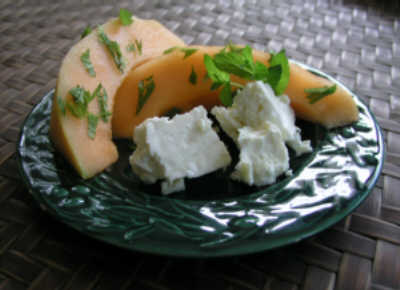
Around the Mediterranean, melon and cheese are often paired. Nowhere is the combination more refreshing than in Turkey, where one of us has lived. Today’s mid-day meal needed only some warmed whole wheat pita bread and snippets of fresh spearmint to enhance the half cantaloupe and 4 oz. chunk of feta* cheese we shared.
* Feta is the Greek name for a soft, crumbly white cheese that may be made from cow’s and/or sheep’s milk. Popular throughout the Balkans and Middle East, it’s long been made throughout those regions. Now there are internationally marketed brands coming from Denmark, France, Britain, Canada, and the US, as well as the traditional producers like Greece and Turkey. Our favorite is Bulgarian, but in Sarasota, we’re happiest with the tangy American Président label ($2.99 lb. at BJ’s).
Cantaloupe $0.88 (and we’ve used only half)
Feta Cheese $0.75 for 4 oz. ($2.99 lb at Richard’s Whole Foods and BJ’s)
Total food stamp funds remaining: $12.67 – 1.63 = $11.04
Beverage Disclosure
Food Stamp Challenge aside, we rarely buy any bottled or canned soft drinks. But we do drink cold tea throughout the day. We vary our additives according to what we have around, but here’s our basic recipe.
Chilled, Spiced Tea (makes about 2 quarts)
3 Heaping tsp. loose black tea or 4 teabags
(we buy whatever black tea or “orange Pekoe” is on sale, usually 100 bags for @ $2)
2-3 Nickel-sized pieces of fresh ginger root
1/4 Teaspoon ground cinnamon (2-3 shakes from a jar with a perforated top)
2-3 Wedges of lime, lemon, orange or even leftover citrus rind (ok if you’ve already squeezed out the juice for something else)
Place the tea and other ingredients in a large teapot. Bring 1 quart of water to a boil and pour it into the teapot. Stir pot to settle the tea. Let stand 4-5 minutes. Meanwhile, bring one more quart of water to a boil.
Strain brewed tea (it will be very strong) into a 2-quart, heat-resistant vessel that will fit in your refrigerator. Refrigerate this half-full vessel.
Leave all the ingredients in the teapot and refill it from the boiling kettle. Let this weaker tea sit until it has cooled slightly. Strain and add to the first batch. We usually reserve the ginger slices (which are still very flavorful) and put them into the cold tea vessel. Sweeten, if you must, but the aromatics may just pacify your sweet-tooth. Chill and enjoy with or without ice.
Supper Saturday:
We wanted our last meal to be special. The weather deities of south Florida had other ideas, but in the end, they relented enough to allow us to grill a steak. On our last foray to Sweetbay supermarket, we found beef chuck shoulder steak on sale at $1.49 per pound. While this cut of beef is not as inherently tender as New York strip or rib eye, it’s well marbled and flavorful, and much less costly: just the sort of cut that benefits from a long marinade. The boneless piece we brought home was destined for tagliata, an Italian steak salad.
Tagliata means ‘cut,’ in reference to the method of serving this salad. Ordinarily, a steak is marinated, grilled, then sliced diagonally into strips, tossed with greens, and dressed with olive oil and lemon juice. The traditional leafy component for tagliata is arugula, a green that does not grow well in hot weather. We decided against a short drive to Whole Foods, where arugula is nearly always available (about $2. 50 a bunch). That would have pushed our budget limits. Furthermore, we have been trying to consume as much Florida-grown produce as possible, for this experiment and in ‘real life.’ To quote Cole Porter again, “It’s too darn hot.” Arugula and other bitter greens are surely growing in shade-houses somewhere right now, but under the July skies of Sarasota, no way.
Watercress ($0.89 a bunch at our Vietnamese grocer, and a bit more at Sweetbay) would have been another good choice, but as we were in the middle of una tempesta, a downpour, driving anywhere wasn’t advisable. The most prudent choice seemed to be the heart of Romaine we had left from last week’s trip to the Red Barn.
The classic marinade for tagliata is a simple mixture of olive oil, sliced garlic, and rosemary. Because we knew our shoulder would need some tenderizing, we added acid: 3/4 cup of yellow grapefruit juice. (We still have some over-ripe grapefruit clinging to the tree in our yard.) We let the meat marinate in the fridge for about four hours.
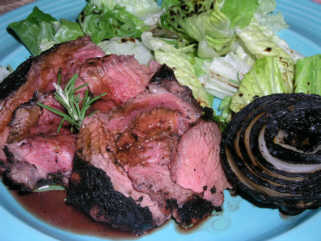
At dinnertime, we grilled the steak (over palmetto again) until rare* and let it rest, covered, for approximately ten minutes. (As an accompaniment, we also grilled two halves of a sweet, white Florida onion.) We sliced the meat on the bias into 1/2 in. slices and served it over the Romaine, with an additional dressing of olive oil and balsamic vinegar .
The last two ciabatta rolls rounded out this final feast.
* Even at $1.49 per pound, we consider our steak to be an investment. As such, we wanted it to be as good as it could be. Though we hovered around the grill as it cooked, we wanted another edge. We used an instant-read thermometer to assure that we’d remove the steak from the grill when it reached an internal temperature of 120 F. We expected the temperature to rise an additional 5 degrees in carry-over cooking as the steak rested; an internal reading of 125 F. gave us a perfectly done, rare steak.
1.73 Lb. boneless beef shoulder roast: $2.58
Misc. bread for the week: $3.00
Total food stamp funds remaining: $11.04 – 5.58 = $5.46
In a couple of days, we’ll write a summary and assessment of our participation in the Food Stamp Challenge. With nearly $5.50 left over, we feel we’ve done very well. However, the real challenge lies ahead. How do we encourage actual food stamp recipients to look at our example and devise their own ways to prepare and share better meals with their families and friends.
Links to the other posts in our series:
Living on $42.00 Per Week—the Challenge
Living on $42.00 Per Week—Day 1
Living on $42.00 Per Week—Day 2
Living on $42.00 Per Week—Day 3
Living on $42.00 Per Week—Day 4
Living on $42.00 Per Week—Day 5
Living on $42.00 Per Week—Day 6
Living on $42.00 Per Week—Summary
Living on $42.00 Per Week—Redux
Living on $42.00 per Week-Day 6
July 21st, 2007Total food stamp funds remaining: $17.87.
Lunch Friday:
Another pattern emerging from our experiment is that one day’s lunch is often based on leftovers from the previous night’s supper. We don’t see this as a bad thing. It’s a legitimate way to extend the grocery budget, reduce labor, and get a nourishing meal at noontime. And if the original meal was good, we don’t consider leftovers hardship fare.
With the beaten eggs and the halibut collagen, last night’s avogolemono soup was sufficiently rich that we were very satisfied with one bowl, and a smaller second helping. That left us with nearly three cups of soup available for lunch today. And though we didn’t mention it yesterday, we now have 1 1/2 quarts of fish stock in our freezer as well.
Today, for variety, we added nearly 1/4 Lb. of linguine from our miscellaneous, won’t-quite-serve-two pasta inventory. We broke the raw pasta into 1-inch bits and simmered it in the leftover soup till it was al dente. Avogolemono bonds with starch, so a soup can be thickened by adding potatoes, rice, or pasta. With our linguine-thickened avogolemono, we had yet another ample lunch.
Supper Friday:
It was hot, but not unreasonably so, and a great evening for grilling. At our local Sweetbay grocery store, we found a 20 oz. package of 5 Hot Italian sausages for $3.49. We’ve been fans of Sweetbay’s sausages since we first tried them. One of us spent 25 years living in the North End of Boston (THE Italian section where there’s an Italian butcher on nearly every corner). We like Sweetbay’s sausages better than any we ate there.
Sweetbay has a central corporate kitchen in Tampa which supplies all their stores in Florida. We have six Sweetbays in metropolitan Sarasota alone; all sell great sausages. We like to think about a Tuscan nonno—an Italian grandfather—coming into the corporate kitchens as a consultant on sausage-making days:” No, un po più di finnocchio; più peperoncino!” a little more fennel; more hot pepper, he says as workers pour pounds of ground pork and seasonings into a huge mixer. At a certain point in the process, he carefully sautés a small portion of the stuffing, takes a practiced taste, and pronounces, “Ah, salsiccia buona.” And they’re done.
The nonno may be there, he may not, but Sweetbay’s sausages stand out among the best.
We noticed one of the Sweetbay butchers hunched over his work table, knife flashing from time to time. We inquired about what he was carving and he replied, “Beef heart, $1.49 per pound.” This struck us as a superb bargain, and suddenly we were thinking about a Tuscan mixed grill for supper.
Beef heart is a member of that class of meats euphemistically known as “variety cuts,” or offal. Marinated, grilled on a skewer, and called anticucho, it’s a very popular street food in Peru. Apparently we have enough Peruvians and other beef heart-eaters to give Sarasota criticial mass, and thus make it worthwhile for supermarkets to keep it in stock. At $1.49 per pound, it’s a very inexpensive way to get high quality protein that does not require a lot of preparation.
Ferreting around in a cabinet beneath the kitchen counter, we found a bag of harina de mais fina amarilla, fine yellow corn meal we had bought a while ago at a Latino market. It turns out that this corn meal makes superb polenta. (Imported Italian corn meal for polenta runs about $3 for a 17.5 oz. package. We got 16 oz.of Mexican harina for 69 cents.)
And since we were going to have the grill going for the meats, we thought it would be a fine time to roast some of the bell peppers we’d bought earlier this week at the Red Barn. (We are fuel-frugal, too.)
This was shaping up to be a glorious, trattoria-style feast. Only the beef required any degree of prep work: we marinated four slices (about 8 oz.) in a mixture of red grapfruit juice (While foraging, one of us had scored a fallen, late-harvest grapefruit on a neighbor’s lawn earlier in the afternoon). Our marinade was simple: the grapefruit juice with just a splash of olive oil, sliced garlic, ground black pepper, and fresh rosemary (we have a veritable rosemary “shrub” growing in our front yard).
We’ve written before about grilling over palmetto and using the woody stalks of the palm fronds. Since we live in a neighborhood checkered with palm trees, finding this aromatic fuel for our domed Webber grill (another trash day street-find) is never a problem. Palmetto burns much hotter than charcoal, but the fire doesn’t last as long, so we supplement our fires with ten to twelve lumps of hardwood charcoal. Nevertheless, palmetto smoke imparts a delicious and distinctively Floridian flavor to meats.
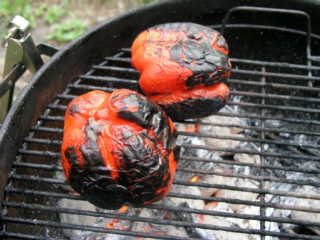
We put the peppers on the fire before it really settled down to embers, because we wanted to get a good char on the skins for easy peeling.
When they were done, we took them off the grill, redistributed the coals and added more palmetto before putting on the sausages and beef heart.
Total food stamp funds remaining: $17.87 – 5.20 = $12.67
Now is as good a time as any to remind ourselves that to fully satisfy, food should please the eye as well as the palate. If you take the time to cook, don’t eat dinner in front of the TV or standing over the kitchen sink. Take the time to plate your creations, then sit down at the table to savor rewards well earned.
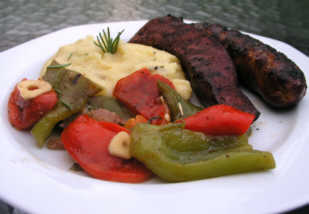
Links to the other posts in our series:
Living on $42.00 Per Week—the Challenge
Living on $42.00 Per Week—Day 1
Living on $42.00 Per Week—Day 2
Living on $42.00 Per Week—Day 3
Living on $42.00 Per Week—Day 4
Living on $42.00 Per Week—Day 5
Living on $42.00 Per Week—Day 7
Living on $42.00 Per Week—Summary
Living on $42.00 Per Week—Redux
Living on $42.00 per Week-Day 5
July 20th, 2007Lunch Thursday:
Lunch today was catch-as-catch-can. One of us had a dental appointment that caused involuntary facial contortions from Novocaine, and the other had mid-day business in Lakewood Ranch.
When we finally came together for a meal, it was nearly 3:00 p.m., and we were (metaphorically) “famished.” Knowing that this is when we or anyone is most likely to succumb to indiscriminate snacking, we did not simply plunge into the larder in search of instant gratification. Instead, we made a simple salad of 1/2 an avocado, a plum tomato, chopped Italian parsley, the grated rind & juice from half a lime, a squirt of hot sauce, and 2 tablespoons of sunflower seeds. (We buy ours in bulk, dry-roast them in the toaster oven and keep them on hand for occasions like this.) We had our salad with a two heated rounds of whole wheat pita bread. We took no more than 10 minutes to prepare everything, and there was just enough food to take the edge off until supper. Furthermore, we had a chance to sit down, talk, and relax a bit in the midst of a very busy day.
Kitchen tools: (Williams-Sonoma will hate us)
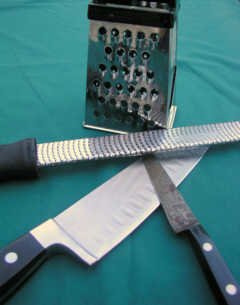
We began this project with a toolkit: Interest, enthusiasm, experience, appetites, and skills. But we couldn’t have implemented much of what we’ve done without tangible tools. For years, we’ve been reading about “the one kitchen tool” some rock star chef “can’t live without.” In our case, we can’t identify just one, but here, in no order of priority, are four inexpensive tools we feel every kitchen should have.
A Box Grater. We admire Mario Batali for his ability to create a snow-shower of Parmigiano with his Microplane grater. We question how much of the cheese finds its way onto the food, but it looks spectacular on TV. For most of our basic grating needs though, we rely this old standby.
A Chef’s Knife. We’ve read and heard all the hype about Wusthof, Henkel, Global, and recently, Kyocera. But for us, our knives (with or without pedigree) must be comfortable to be useful. And any knife can be sharpened. We found our Sabatier Santoku knife at T.J. Maxx for $9.95. It’s the bargain end of the Sabatier line but it feels good. However, before we brought it home, we took it to our local True Value hardware store and had it professionlly sharpened for $4.00. Now we have a tool that’s a pleasure to use in the kitchen. We simply give it a few swipes with a sharpening steel and make short work of whatever we chop or slice.
A Paring Knife. Ours is so old, we’re no longer sure where we bought it. But it, too, is French. Made from carbon steel, it has been professionally sharpened as well. It’s an invaluable instrument for the finer jobs we do in the kitchen, like dissecting meat from fish frames.
A Microplane Grater. At approximately $12.00, some might perceive this as a luxury. Beyond its obvious use for grating hard cheeses, this is sine qua non for grating citrus rind, fresh ginger, and carrots. We’ve even used it for making extra-fine bread crumbs. With the capabilities it’s given us, it has paid for itself many times over.
Supper Thursday:
After our ceviche meal, we banked our greatest bargain: we froze the Whole Foods halibut frame until we could afford it the time and thought it deserved. The Novocaine had worn off and one of us was still feeling a little sore, so a hearty soup seemed a good choice for supper. Cue in the fish frame…
In a large pot, we barely covered the fish frame with 10-12 cups of water. At this stage, our only seasonings were two bay leaves and about twenty black peppercorns. We brought the pot to a simmer; the broth began to perfume the kitchen. And we really mean that. There’s a reason professional cooks hold pricey halibut in such high esteem. Our broth was not fishy, but fresh—like an evening at the beach. As the broth hovered around a simmer, we began to gently scrape at the bones to release whatever meat still remained on the frame.
We’d planned to add some pieces of inexpensive frozen ocean perch ($3.49 for a 1 lb. bag at Sav-A-Lot, and we did have some in our freezer). However, we’d already gleaned more than a cup of halibut from the frame. The wafting stockpot aroma was so pure that we began to say things like, “You know, we may not need to add any more fish or seasonings…” But we did put one whole carrot into the stock, which we removed and reserved later, while it was still intact.
After about an hour, we strained the stock into another pot and picked as much of the meat as we could from the cooked bones. When we were done, we definitely had enough halibut meat for two.
But then, being foodies, we faced a dilemma: we wanted a simple preparation that would not obscure the halibut flavor. We had thought briefly about cotriade, a very simple fish soup from Brittany, and we had considered a minimalist version of soupe de poisson, the classic Provençal fish stew, which would have demanded olive oil, tomatoes, a bouquet of herbs, and saffron (all of which we had within reach). But to best illustrate frugality with flair, we chose the classic Mediterranean egg and lemon soup frequently known by its Greek name, avogolemono. The mixture can also be a sauce—enhancing poultry, meat, fish, and vegetarian dishes throughout the Eastern Mediterranean. It’s a great way to stretch a couple of eggs and a single lemon.
Four small, red-skinned potatoes, cut into bite-sized pieces and 4 cloves of chopped garlic went into the strained, simmering stock.
Into a separate bowl, we grated the rind of one lemon, then added its juice. We scrambled two large eggs and the juice until they were well-combined, beginning to froth. We couldn’t pour this mixture directly into the stock, or we’d have fish stock with scrambled eggs. So we took a ladle of stock, poured it into the eggs-with-lemon and fork-stirred to blend and bind the mixture—to “temper” the eggs. After adding two more ladles of hot liquid, we stirred the egg and lemon mixture into the stock. Having checked to be sure the potatoes were tender, we sliced the reserved carrot and added it to the broth. After tasting for salt, we were done.
A little finely chopped parsley for garnish, two ciabatta rolls, and we had one of our most elegant suppers yet.
Links to the other posts in our series:
Living on $42.00 Per Week—the Challenge
Living on $42.00 Per Week—Day 1
Living on $42.00 Per Week—Day 2
Living on $42.00 Per Week—Day 3
Living on $42.00 Per Week—Day 4
Living on $42.00 Per Week—Day 6
Living on $42.00 Per Week—Day 7
Living on $42.00 Per Week—Summary
Living on $42.00 Per Week—Redux



